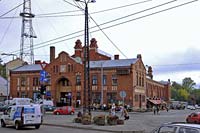| Area: | 460,79 ha |
| % from area of Latvia: | 0,007 % |
| Population: | 31 150 |
| % of Latvian population: | 1,37 % |
History and outstanding values
Outside the centre of Riga one of the most characteristic and interesting historical districts of this city is Agenskalns.
The name of the neighbourhood stems from the fact that in 17th century here was located manor of Riga judge Henrich von Hagen - Hagenshof - this property included lands between the contemporary Ranka dambis and Kuldigas Street. Up to the 17th century this area was comparatively sparsely populated but gradually here arrived more and more inhabitants - mainly of Latvian nationality. At the end of 18th century major part of Agenskalns was included in Riga and turned into popular district of summerhouses (characteristic "manor houses" of Riga) for prosperous citizens of Riga of German nationality and location of entertaining events.
Nearly all current buildings in Agenskalns have been built after 1812 - then - during the Napoleonic war - the buildings of Agenskalns were dismantled. Initially there was built a chaotic group of wooden buildings characteristic for the beginning of 19th century - comparatively many of these houses have survived up to this day and constitute one of the main values of neighborhood. Network of narrow, crooked streets together with these wooden buildings between Nometnu Street and Eduarda Smilga Street form the historical centre of Agenskalns - city building monument of state importance.
At the end of 19th century - beginning of 20th century there was formed the current centre of Agenskalns around the expressive Agenskalns market building. In 1910 there nearby was built the wast, elegant complex of 2nd city hospital (Pauls Stradin's Clinical University Hospital).
In total Agenskalns is characterised with large number of diverse monuments of architecture - in streets of this neighborhood there are standing next to each other wooden buildings from the beginning of 19th century, ornate Jugendstil apartment buildings and simple, elegant buildings in Functionalist style. Characteristic feature of neighborhood is sun-lounge with large glasses and smaller colored glasses. Distinguished values are church of St. Martin and Martina cemetery - one of the oldest cemeteries in Riga where are buried mainly Latvians. In the neighborhood there are located also several historical parks including Uzvara park, major part of picturesque Arkadija park.
List of described monuments
Table lists the described monuments of Agenskalns. Grey colored monuments have not been preserved up to this day.
| No | Name | Category | Images? |
|---|---|---|---|
| 18 | Pastorate of Riga St.Martin's church Latvian parish in Martina 3 | Pastorates | yes |
| 19 | Zuckerbecker manor | Palaces and manor houses | yes |
| 20 | Hamann manor | Palaces and manor houses | yes |
| 21 | The new building of Hartmann manor, Kalnciema 30 | Palaces and manor houses | yes |
| 22 | The old building of Hartmann manor, Kalnciema 28 | Palaces and manor houses | yes |
| 23 | Hay manor | Palaces and manor houses | yes |
| 24 | House of Leluchin | Urban apartment houses | yes |
| 25 | Manor at Mara pond | Palaces and manor houses | no |
| 26 | House of Nindel | Urban apartment houses | yes |
| 27 | House of Pusmuiznieks | Manor centre buildings | yes |
| 28 | House of Schroeder | Palaces and manor houses | yes |
| 29 | Svarcmuiza mansion | Palaces and manor houses | yes |
| 185 | Pastorate of German St.Martin's parish in Balozi Street 27 | Pastorates | yes |
References
- Apkaimju vēsturiskais apraksts, Biedrība Ideju māja, 2008 (Historical description of neighborhoods)


